Research Questions
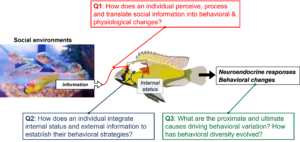
Main Projects
Project 1: Investigate Neural Mechanisms of Olfactory-Driven Social Behaviors in African Cichlids
Why study cichlids?
African cichlids provide a remarkable example in evolutionary biology due to their rapid speciation, resulting in a vast diversity of forms and behaviors over the last 10 million years. These fish have been instrumental in studying various processes, including the regulation of neural circuits controlling social behavior and the evolutionary changes that have led to the development of new traits. In our lab, we focus on Astatotilapia burtoni, an emerging model organism and highly social cichlid, to uncover the mechanisms behind olfactory-driven social behavior. A. burtoni exhibits complex and well-documented social behaviors, such as plastic and reversible social hierarchies, that are rarely seen in other aquatic model species. Male cichlids are known for their pronounced aggression and display stereotyped mating and territorial behaviors. Notably, the A. burtoni genome has been sequenced, and both forward and reverse genetic tools have been developed by our lab and other research groups.

What have we discovered so far?
Reproductive behaviors vary widely across species, but the underlying mechanisms that govern diversity in mating and parental care systems remain poorly understood. In many animals, pheromones play a crucial role in guiding mating and parental behaviors. However, the evolutionary pathways by which vertebrate pheromone signaling leads to new reproductive strategies are still unclear. In fish, prostaglandin F2α (PGF2α) drives reproductive pheromone signaling in fertile females, yet this activity seems restricted to specific lineages. The mechanism by which female fertility pheromones are detected remains unknown for most fish species. Using single-cell transcriptomics and CRISPR gene editing in a cichlid fish model, A. burtoni, we have identified and tested key genes involved in the olfactory detection of reproductive cues. Our findings reveal that the pheromone receptor Or113a detects fertile cichlid females and facilitates male attraction and mating behavior by sensing a ligand other than PGF2α.
While many cichlid species exhibit extensive parental care, it is typically provided by females. However, we found that males initiate mouthbrooding parental care when signaling in ciliated sensory neurons is disrupted by a cnga2b mutation or when Or113a is inactivated. These results indicate that distinct pheromone signaling mechanisms govern reproductive behaviors across species. Moreover, they suggest that the Or113a receptor has evolved a novel role in regulating behavior, specifically inhibiting paternal care among haplochromine cichlid fishes. Our findings also suggest that a sexually dimorphic, evolutionarily derived parental behavior is controlled by central neural circuits present in both sexes, with olfactory signals acting as a sex-specific gate for these behaviors.
This ongoing project will explore three key directions:
- What are the neural mechanisms that modulate long-term mouthbrooding behavior in males?
- What are the key pheromone ligands that induce mating preferences and suppress male mouthbrooding behavior?
- Are other social behaviors, such as aggression, mediated by these pheromone cues? If so, what are the olfactory mechanisms driving these behaviors?
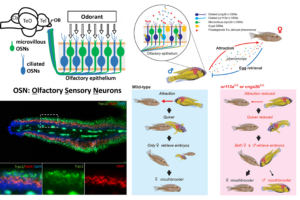
Related publications:
Li CY, Bowers JM, Alexander TA, et al. 2024 .A pheromone receptor in cichlid fish mediates attraction to females but inhibits male parental care. Curr Biol. 34:3866-3880.e7. https://doi.org/10.1016/j.cub.2024.07.029
Li CY, Lawrence K, Merlo-Coyne J & Juntti SA. 2023. Prostaglandin F2α drives female pheromone signaling in cichlids, revealing a basis for evolutionary divergence in olfactory signaling. PNAS. 120:e2214418120. https://doi.org/10.1073/pnas.2214418120
Project 2: Establish the Relationships between Neuroendocrine Systems, Social Experience, Aggressive and Cognitive Behavior in mangrove rivulus killifish
Why study mangrove rivulus?
The mangrove rivulus, Kryptolebias marmoratus, is one of only two self-fertilizing hermaphroditic vertebrates, capable of producing offspring that are genetically identical to both the parent and all siblings. This species offers a unique opportunity to explore how genetic and environmental factors jointly influence social behavior (e.g., aggression and cognition), life history traits, physiology, and brain function. Individuals with identical genotypes can be subjected to different environmental conditions to assess environmental contributions to behavior and physiology; conversely, animals with different genotypes can be placed in the same environment to evaluate genetic contributions. Few studies have examined phenotypic plasticity in ‘clonal’ organisms. K. marmoratus is widely distributed from Central America to northern Florida, with diverse genotypes across various geographic regions. Despite belonging to the same species, these fish exhibit dramatically different behavioral responses to the same social stimuli due to their genetic diversity. Moreover, there are some fascinating traits of this species including:
1) They can change sex from hermaphrodite to male, and these two sexes exhibit significantly different social behaviors and neural physiological responses, even with identical genomes!
2) They can crawl and jump across mangrove wetlands and survive out of water for over two months!
These remarkable features make K. marmoratus a valuable species for studies from neurophysiological mechanisms, behaviors to ecology and evolution.
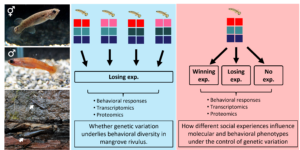
What have we discovered so far?
Neuroendocrine systems have long been reported to associate with social behaviors, but these relationships can be altered by multiple internal (e.g., sex, hormone levels, genotypes) and external (e.g., social interaction, contest experiences) factors. We use a mangrove rivulus fish, Kryptolebias marmoratus, to reveal how these components (sex, endocrine status, fighting experience) interact with each other, and generate the ultimate behavioral output.
We first discovered a suite of highly correlated behaviors, including aggression, boldness and exploration, across multiple situations (behavioral syndrome), and these correlations are mediated through testosterone and cortisol levels. Second, We discovered that in mangrove rivulus fish, despite being genetically identical, sex (males vs. hermaphrodites) significantly influences their aggression, fighting strategies and endocrine responses to contests. Third, we discovered that the effect of contest experience on androgen receptor (AR) gene expression depended on testosterone (T) levels: repeated losses decreased, whereas repeated wins increased AR gene expression in individuals with low T but not in individuals with medium or high T levels. These results lend strong support for AR being involved in mediating winner-loser effects, and help us to understand how internal and external factors interplay with each other and shape behavioral output. Lastly, we showed that contest winners become more aggressive and better at spatial learning, while losers decrease their aggression and improve risk-avoidance learning. Collectively, these results provide evidence that the experience of winning or losing modulates a diverse set of behaviors served by key brain regions within the social decision-making network, including the dorsolateral pallium (Dl; fish homolog to the hippocampus) and dorsomedial pallium (Dm; fish homolog to the basolateral amygdala). We also quantified whole-proteome expression within the forebrain (where Dm and Dl nuclei are located) of adult rivulus with divergent fighting experiences (winning/losing/control) and identified ~1300 proteins; 23 of these were significantly differentially expressed among individuals with divergent social experiences. These results suggest that functional differences arise in the brains of winners and losers with implications for expression of aggression and learning behavior.
This ongoing project will explore three key directions:
- Investigate the brain transcriptomics and proteomics responses to different social experiences in individuals with previous winning, losing, and control experiences, and then identify a suite of target genes/proteins responding to these social stimuli.
- Compare and contrast the brain transcriptomics and proteomics responses among different lineages of mangrove rivulus.
- Genetically manipulate the target genes to establish the causality of gene-behavior relationships.
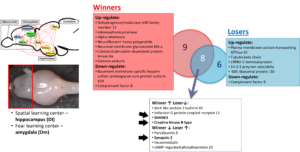
Related publications:
Li CY, Kültz D, Ward AK, Earley RL. 2021. Social experience alters different types of learning abilities controlled by distinct brain nuclei in Kryptolebias marmoratus. bioRxiv. https://doi.org/10.1101/2021.04.25.441338
Li CY, Huang SP, Garcia M, Fuller A, Hsu Y, Earley RL. 2018 Sexual phenotype drives variation in endocrine responses to social challenge in a quasi-clonal animal. R Soc Open Sci. 5:180002. https://doi.org/10.1098/rsos.180002
Li CY, Earley RL, Huang SP, Hsu Y. 2014. Fighting experience alters brain androgen receptor expression dependent on testosterone status. Proc Biol Sci. 281:20141532. https://doi.org/10.1098/rspb.2014.1532
Chang C, Li CY, Earley RL, Hsu Y. 2012. Aggression and related behavioral traits: the impact of winning and losing and the role of hormones. Integr Comp Biol. 52:801-813. https://doi.org/10.1093/icb/ics057
Project 3: Develop and Improve Genetic Tools and Other Molecular Tools in Non-traditional Aquatic Model Organisms
African cichlids and mangrove rivulus have been used to study various processes, including the modulation of neural circuits controlling social behavior and the evolutionary changes that give rise to new traits. However, due to the lack of suitable genetic tools, it has been challenging to directly test the causal relationships between genetic mechanisms and behavioral traits. During my postdoctoral training, I made significant progress in applying and refining reverse genetics tools in both species, generating loss-of-function modifications in targeted genes. With this improved pipeline, we can efficiently produce loss-of-function mutations and screen for the genetic mechanisms underlying morphology and complex social behaviors. We will continue improving and enhancing more genetic tools, such as tissue-specific knockin/knockout and the Tol2 transposon system to introduce transgenes into the A. burtoni and K. marmoratus genomes.
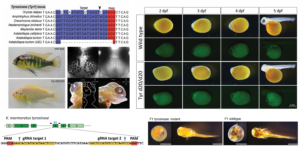
Related publications:
Li CY, Boldt H, Parent E, Ficklin JA, James Altheia, Anlage TJ, Boyer LM, Pierce BR, Siegfried K, Earley RL, Harris MP & Haag ES. 2023. Genetic tools for the study of the mangrove killifish, Kryptolebias marmoratus, an emerging vertebrate model for phenotypic plasticity. J Exp Zool B Mol Dev Evol. 342:164-177. https://doi.org/10.1002/jez.b.23216
Li CY, Steighner JR, Sweatt G, Thiele TR, Juntti SA. 2021. Manipulation of the Tyrosinase gene permits improved CRISPR/Cas editing and neural imaging in cichlid fish. Sci Rep. 11:15138. https://doi.org/10.1038/s41598-021-94577-8
Other Projects
Project 4: Design and Improve Behavioral Apparatus for Assessing Social and Cognitive Behavior
I have been fascinated by complex social behaviors since the very beginning of my research career. Aggression, one of the most fundamental yet intricate social behaviors, has been studied for centuries. However, designing an ideal apparatus to assess aggression poses a challenge, as aggressive displays vary significantly between species.
We made a significant contribution by designing the non-reversing mirror test, an improved setup for quantifying aggression in animals that rely heavily on head-tail lateral displays. In contrast, the traditional mirror aggression test, which has been used for decades, is more suitable for species that exhibit parallel displays. Our work highlights the importance of carefully interpreting responses to different stimuli, as they vary greatly in how closely they resemble interactions with a live conspecific. Additionally, we demonstrated that using inappropriate setups to assess aggression can induce fear responses rather than aggression, potentially leading to misinterpretations of behavioral outcomes. Lastly, we emphasize that the fish brain is remarkably sophisticated, capable of detecting subtle differences in social interactions, such as specific display orientations, which enables the discrimination between real and artificial opponents.
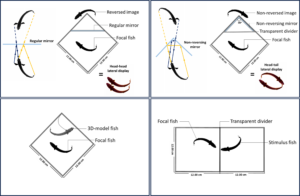
Related publications:
Li CY, Curtis C, Earley R. 2018. Nonreversing mirrors elicit behaviour that more accurately predicts performance against live opponents. Anim Behav. 137:95-105. https://doi.org/10.1016/j.anbehav.2018.01.010
Li CY, Hofmann HA, Harris ML, Earley RL. 2018. Real or fake? Natural and artificial social stimuli elicit divergent behavioural and neural responses in mangrove rivulus, Kryptolebias marmoratus. Proc Biol Sci. 285:20181610. https://doi.org/10.1098/rspb.2018.1610
Project 5: Decipher animal contest decision and fighting strategy (Collaborate with Dr. Yuying Hsu at National Taiwan Normal University.)
Animals often engage in agonistic interactions when competing for limited resources; thus, identifying potential factors that influence the contest decision, dynamics and outcomes is of fundamental importance to behavioral scientists. My master’s research focused on understanding what these factors are and how they influence fighting strategy and contest decision using a mangrove rivulus fish, Kryptolebias marmoratus. We discovered that both personality traits (aggression and boldness) and physiological traits (testosterone and cortisol) provide useful predictors for the fish’s contest decisions, in which fish with higher aggression or higher levels of testosterone were more likely to initiate attacks and win contests, while individuals with higher levels of cortisol were more likely to lose. But surprisingly, opponent size does not affect an individual’s contest decisions during assessment stage. Lastly, We discovered that opponent familiarity coordinate with previous fighting experiences to affect contest decision. These works test the possible factors which determine contest initiations and dynamics and improve our knowledge of animal fighting behavior.
Related publications:
Li CY, Pan CY, Hsu Y. 2023. Age-dependent winner-loser effects in a mangrove rivulus fish, Kryptolebias marmoratus. Animal Cognition 26:1177-1488.
https://doi.org/10.1007/s10071-023-01797-8
Li CY, Tseng YC, Chen YJ, Yang Y, Hsu Y. 2020. Personality and physiological traits predict contest interactions in Kryptolebias marmoratus. Behav Processes. 173:104079. https://doi.org/10.1016/j.beproc.2020.104079
Li CY, Jones R, Earley R. 2018. Contest decisions are governed by own size and opponent size category in mangrove rivulus fish, Kryptolebias marmoratus. Anim Behav. 146:97-103. https://doi.org/10.1016/j.anbehav.2018.09.020
Li CY, Yang Y, Lee PY, Hsu Y. 2014. Opponent familiarity and contest experience jointly influence contest decisions in Kryptolebias marmoratus. Front Zool. 11:92. https://doi.org/10.1186/s12983-014-0092-7